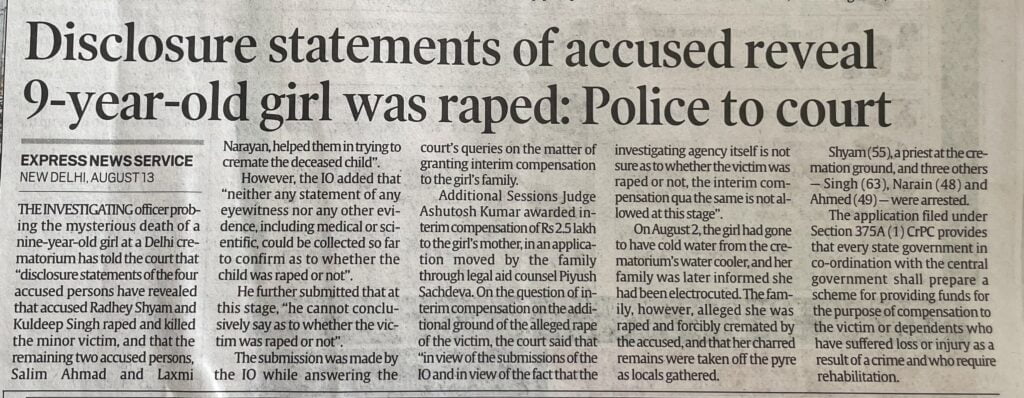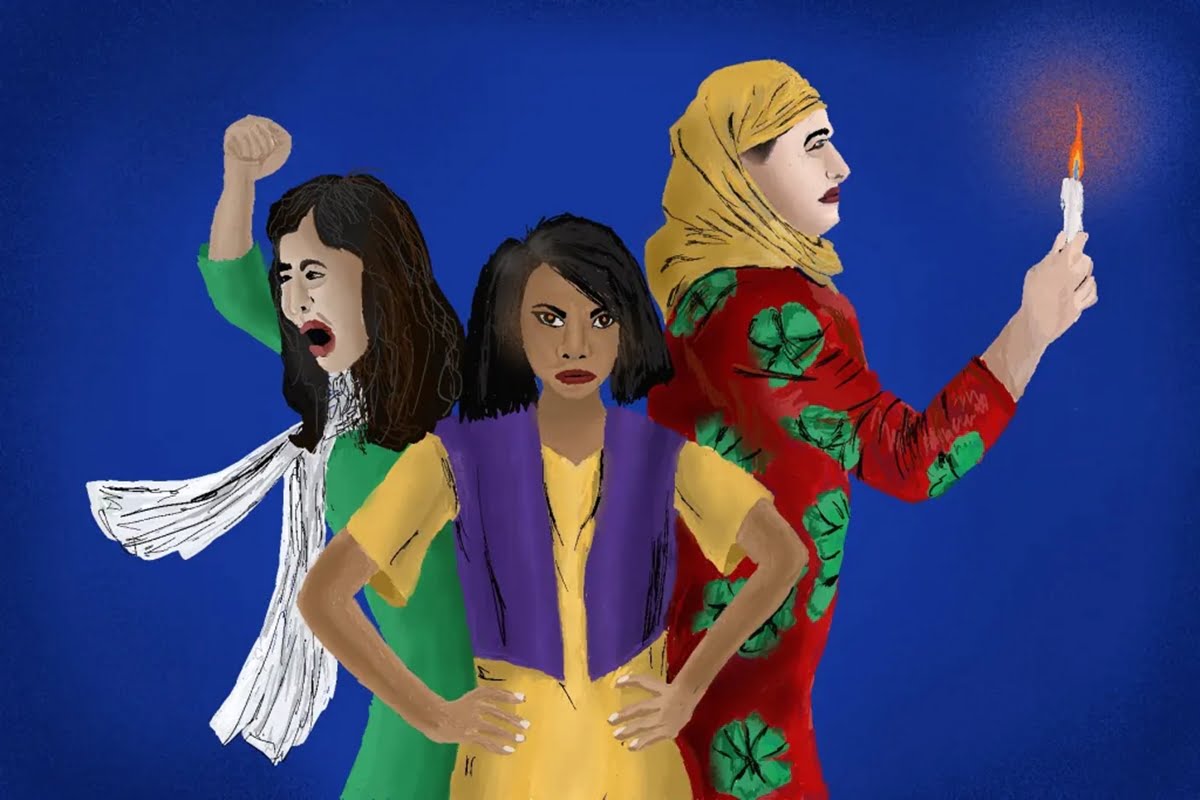On August 2, a 9-year-old Dalit girl was found gangraped and murdered at a crematorium in Delhi Cantonment area, Southwest Delhi. Before the Dalit community could process the grief of the upper-caste atrocity against a minor girl child, another news of the rape of a 6-year-old Dalit girl by her neighbour in Delhi’s Trilokpuri came out on August 12. In retrospect to the angry outbursts I felt every time I heard such terrifying news, this was the first time what I felt was more utter despair towards the faltering justice Dalit women received time and again. Dalits’ resistance stretches as far as back as three thousand years but today they stand exhausted, their mental health dissipating.
I believe this story needs to be told differently: From the perspective of the oppressors, not the oppressed. The nerve-wretching gang rape and murder of a Dalit girl, as young as 9 year old by a 55 year old Brahmin priest, Radhey Shyam and other employees at the crematorium, Kuldeep Kumar (63), Laxmi Narain (48) and Mohd. Salim (49) and of a 6 year old by her neighbour speaks of an ancient story: that of India’s caste system.
What the case is about VS How it is portrayed by the mainstream media/civil society
Every time a Dalit woman is raped, media channels and the civil society’s classic response is to report the crime invisibilising the identity of the survivor/victim and the perpetrator(s). The issue of violence has been addressed very differently in India spanning the last 200 years but in retrospect, a view at the last ten years informs us how sexual violence against Dalit women has been conceptualised by the civil society. It speaks volumes on HOW brahmanical patriarchy has clamoured to universalise the categorisation of ‘violence’, ‘womanhood’ and ‘Indian woman’, encroaching the customary rights of the Dalit women.
Brahmanical patriarchy has clamoured to universalise the categorisation of ‘violence’, ‘womanhood’ and ‘Indian woman’, encroaching the customary rights of the Dalit women.
Any discussion on apparent intersections and divisions of caste and religion has not been taken well by the mainstream civil society and media as it is seen as a move fragmenting the sisterhood. Whose brotherhood and sisterhood, we may ask, when it is rooted in oppressing the voice of a community’s struggle against everyday forms of injustice including repeated acts of humiliation, sexual violence and crime?

According to the data presented by The National Crime Records Bureau (NCRB), 32,033 cases of rape were reported in 2019, meaning 87 women are raped everyday in India out of which 15% are children. The police and civil society do not take cognisance of the caste atrocities when Dalit women and children are raped until Dalit organisations and activists take to the streets protesting for their basic rights.
Also read: Dalit Histories: Beyond The Binary Of Atrocities And Reservation
It was only last year when a 19 year old Dalit girl in Hathras, Uttar Pradesh was gangraped and her body was forcefully cremated by the police without the family’s consent. This is a classic cunning move by the police when sexual violence on Dalit women is carried by dominant men. The police is slow to register an FIR, the investigations dilly-dally, reflecting how ‘power’ operates within judicial administration often siding with upper caste perpetrators as they are wealthy and powerful, the media and civil society anguish over linking the crime with caste.
Dalit women are exposed to work environments which are dominated mostly by savarna men, and therefore work under unsafe conditions with zero control on their mobility and sexuality outside the home/inner world which according to the caste ideology makes them ‘impure’ and ‘easy to please’. Whenever Dalits protest against caste atrocities, sexual violence is used as a weapon by the dominant powerful men to gang rape Dalit women and kill entire Dalit colonies as they feel they have customary rights over Dalit women’s bodies. Questioning of a Dalit woman’s virtue and character takes place when she fights against injustice, marginising Dalit women further.
Right at the heart of the nation’s capital, the 9 year old Dalit girl had gone to fetch drinking water at the crematorium site when the five men attached her. The girl’s father dropped her off at the crematorium at 5:30 PM and informed her to pick her up on his way back from the vegetable market. An hour later, her mother was called by the village priest, Radhey Shyam and four other men who showed her the girl’s body, claiming that she died of electrocution while fetching drinking water. After the mother left the crematorium site trying to make sense of what had happened, the village priest along with the four men cremated her body suspiciously. By the time the mother got this information, she reached the crematorium protesting with other villagers but by then more than half of her body had caught fire and only her feet could be gathered from the burning pyre. The police didn’t allow the family and villagers access to the dead body and warned, “let the last rites take place smoothly” restricting proper evaluation.
Rather than raising relevant questions such as how caste dictates everyday life of Dalit women in India and impedes their freedom of movement and basic rights, majority of news channels reported this crime in a passive language which hides the role of caste in the committed crimes. They used the word “alleged” as if the crimes committed are not brutal enough to reflect the manner in which caste functions in our society. The crime was reported with incomplete heading “rape of a nine year girl” and not “rape of a nine year old Dalit girl” by many media channels which made reporting of the heinous crime just “gender based violence”.
The conversation on caste based sexual violence is important as it throws light on the impunity upper caste men enjoy for perpetuating violence on members of Dalit communities and target Dalit women to specifically teach the Dalit community a lesson often for reminding them their low status and vulnerable positions in society.
Universalising the experience of all girls and women as one is a mistake as it doesn’t take into cognizance that experiences of discrimination which differ due to one’s caste, religion, economic status and nationality. The conversation on caste based sexual violence is important as it throws light on the impunity upper caste men enjoy for perpetuating violence on members of Dalit communities and target Dalit women to specifically teach the Dalit community a lesson often for reminding them their low status and vulnerable positions in society.
Sharmila Rege argues that “The violent practices against women reveal definite variations by caste; while upper castes women are subjected to control and violence within the family, it is the absence of such controls that makes lower caste women vulerable to rape, sexual harassment and the threat of public violence”. I am sure by this Rege didn’t imply that control or violence is absent inside Dalit households but the presence of economic stability and the right to dignity and livelihood makes it easier for the upper castes women to be conformed to the households unlike lower caste women who have to step outside to make a living everyday. An argument on safety, dignity, bodily autonomy, respect, equality, consent and sexism are incomplete unless caste supremacy is taken into account.
Also read: Casteist Abuse Against Vandana Katariya: How Many Dalits Are Too Many Dalits
A thoughtful activity would be to ponder over the reality of a Dalit girl child’s life. The first and foremost question that troubled me was how and why did she have to fetch drinking water from a crematorium sight which is deemed unsafe and unclean in general. According to Hindu Shashtras, communities who work with the midnight soil and dead are given the untouchable status in the caste hierarchy made to settle at the outskirts of the villages/cities. The parents of Tara, the nine year old victim, work as sweepers due to the unavailability of dignified jobs and rehabilitation offered to them by the state. The father of the victim has been unemployed for months and the mother makes a living by doing cleaning work and collecting alms. For the majority of Dalits in India who also remain to be the most economically backward groups, the uppermost priority is to survive.
Caste and gender aren’t entirely separate structures when they operate. Their collision provides us with interlinkages waiting to be explored succinctly. The story of shifting the blame on Dalit women, demeaning their agency and bodies, lobbying done by dominant groups against them is common. What is yet to be witnessed is solid coalitions taking place between the Dalit movement and the women’s movement in India. What’s at stake till then? Mental health of Dalits as they open the newspaper and find caste killing their men, women and children.
Till then, I can only dream of days when such coalitions will take place for real: When upper castes women will raise their voice against the rape of a Dalit woman as fast as they did for Nirbhaya, when Dalit women will not feel they’re alone when dominant caste men exploit them, when dominant castes men will hold the same respect for Dalit women as they do for their own women and children. This system cannot revolutionise until the oppressor communities take accountability of the prevailing prejudices against oppressed groups.
Featured Image Credit: Aasawari Kulkarni/Feminism In India
Disclaimer: Previously the headline of the article erroneously read Two Young Dalit Girls Raped Mere Days Apart: A Testimony Of India’s Negligence. We have changed the headline to better reflect and actively condemn the instances of caste based sexual violence.
About the author(s)
Shainal Verma is a feminist research scholar at the Department of Humanities and Social Sciences, Indian Institute of Technology, Delhi. She is a Writing Urban India fellow and an Institute of Critical Social Inquiry New School fellow. She writes on gender, caste, visual culture, and urban space.





